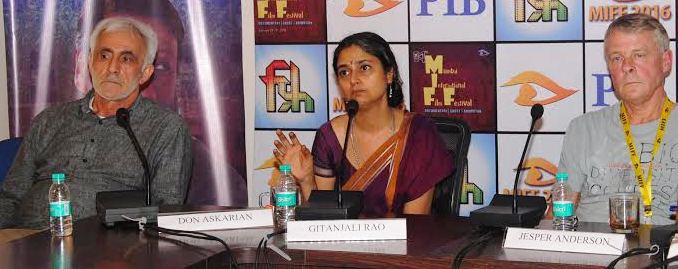|
|
||
|
Pro Tools
FILMFESTIVALS | 24/7 world wide coverageWelcome ! Enjoy the best of both worlds: Film & Festival News, exploring the best of the film festivals community. Launched in 1995, relentlessly connecting films to festivals, documenting and promoting festivals worldwide. Working on an upgrade soon. For collaboration, editorial contributions, or publicity, please send us an email here. User login |
MIFF 2016: Q & A, with the International Jury
MIFF 2016: Q & A, with the International Jury In the last press conference of Mumbai International Film festival (MIFF), three of the five members of the international competition jury came up to the Media Centre on Tuesday, 02 February, met members of the press, and answered various questions related to their experience at MIFF. Jesper Anderson from Denmark is a journalist and film curator, Don Askarian a German film-maker of Armenian origin whose award-winning films are being screened at MIFF and Ms. Gitanjali Rao, an awarded animator, who, too, has a package being screened at MIFF. Jury Chairperson Askarian, who had a workshop on at almost the same time, joined-in late. Jumping directly into a Q & A, the trio invited questions from media-persons. Andersen, who has visited India many times and organises Indian film festivals in Copenhagen, was asked about the standard of films he saw as a jury-member. “I found the long documentaries the most impressive. Short documentaries and short fiction films were not so strong. One way of avoiding this would be: by not waiting for entries to come, on their own. Instead, MIFF, budget permitting, could engage curators, who would look around internationally, for the best on offer. I am willing to scout for the best films from my region, the Scandinavian countries”, he averred. Gitanjali was asked about her feelings on becoming a member of the jury at a festival where she has won the Golden Conch, and where a retrospective of her films is currently being held. “What can I say? It is a great feeling! Till about ten years ago, Indian animators and documentary film-makers were applauded in India only after they had won international recognition. All that is changing now.” When a question was put to her about world and Indian standards in documentary film-making, as experienced through viewing the 37 odd films she saw at MIFF 2016, she said, “I would need to see many more films to comment authoritatively. But in general, I feel international documentaries have not changed much in the last 8-10 years, whereas the Indian documentary is indeed adopting a more international style. Since Indian film schools like the Film and Television Institute of India and Satyajit Ray Film and Television Institute do not really teach documentary film-making, makers either followed the only available model, the Films Division formula, while others went just by their instinct. Having said that, the new age Indian documentaries are highly passionate, and are still very Indian.” Elaborating on the financing scenario in Europe, Askarian said, “Documentary film-making is entirely funded by TV channels and various funds, including funds for films of ‘third world’ countries. Language is no barrier, but you must get your laws and history right. And make sure you teach yourself good film-making. Learn from films. Learn from Stanley Kubrick. Some great films are like teaching books, so log on to You Tube. Before looking for finance, make a very good film. You cannot lie to all the people all the time, and running around with a piece of rubbish will not get you finance.” Anderson and Ms. Rao were asked about exhibition options for documentaries. In Denmark, Anderson pointed-out, documentaries were screened on national TV once a week. “In addition to this, we have had some documentaries releasing in cinemas too.” Ms. Rao said she was happy that TV channels like Epic and NDTV, as well as some Doordarshan channels, were showing documentaries. “But what about animation films? Most animation films are just 3-4 minutes long, yet cost a lot; not many achieve excellence, though they take years to make. Sadly, TV channels do not find them viable, in terms of scheduling. They would need thousands of animation films to sustain a daily slot. I earnestly hope that the government addresses this issue.” (Gitanjali Rao graduated with honours as a Bachelor of Fine Arts from Sir J. J. Institute of Applied Art, Mumbai, in 1994. She is a self taught animator, film maker and theatre artiste, who has produced, directed and animated award winning short films, Orange, Printed Rainbow and True Love Story. Both Askarian and Rao had retrospectives at MIFF). 08.02.2016 | Siraj Syed's blog Cat. : Ambiance
|
LinksThe Bulletin Board > The Bulletin Board Blog Following News Interview with EFM (Berlin) Director
Interview with IFTA Chairman (AFM)
Interview with Cannes Marche du Film Director
Filmfestivals.com dailies live coverage from > Live from India
Useful links for the indies: > Big files transfer
+ SUBSCRIBE to the weekly Newsletter Deals+ Special offers and discounts from filmfestivals.com Selected fun offers
> Bonus Casino
User imagesAbout Siraj Syed Syed Siraj Syed Siraj (Siraj Associates) Siraj Syed is a film-critic since 1970 and a Former President of the Freelance Film Journalists' Combine of India.He is the India Correspondent of FilmFestivals.com and a member of FIPRESCI, the international Federation of Film Critics, Munich, GermanySiraj Syed has contributed over 1,015 articles on cinema, international film festivals, conventions, exhibitions, etc., most recently, at IFFI (Goa), MIFF (Mumbai), MFF/MAMI (Mumbai) and CommunicAsia (Singapore). He often edits film festival daily bulletins.He is also an actor and a dubbing artiste. Further, he has been teaching media, acting and dubbing at over 30 institutes in India and Singapore, since 1984.View my profile Send me a message The EditorUser contributions |




























